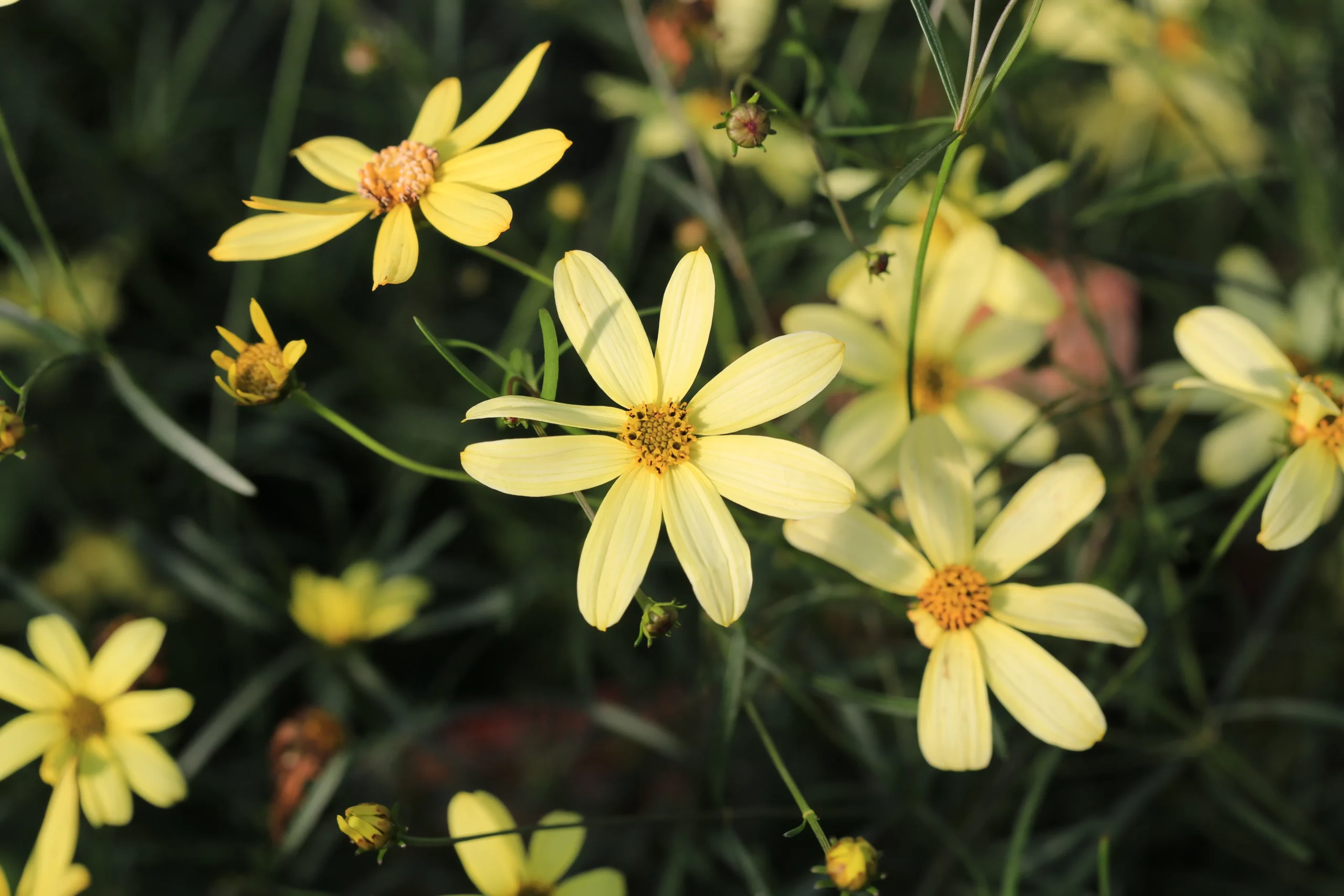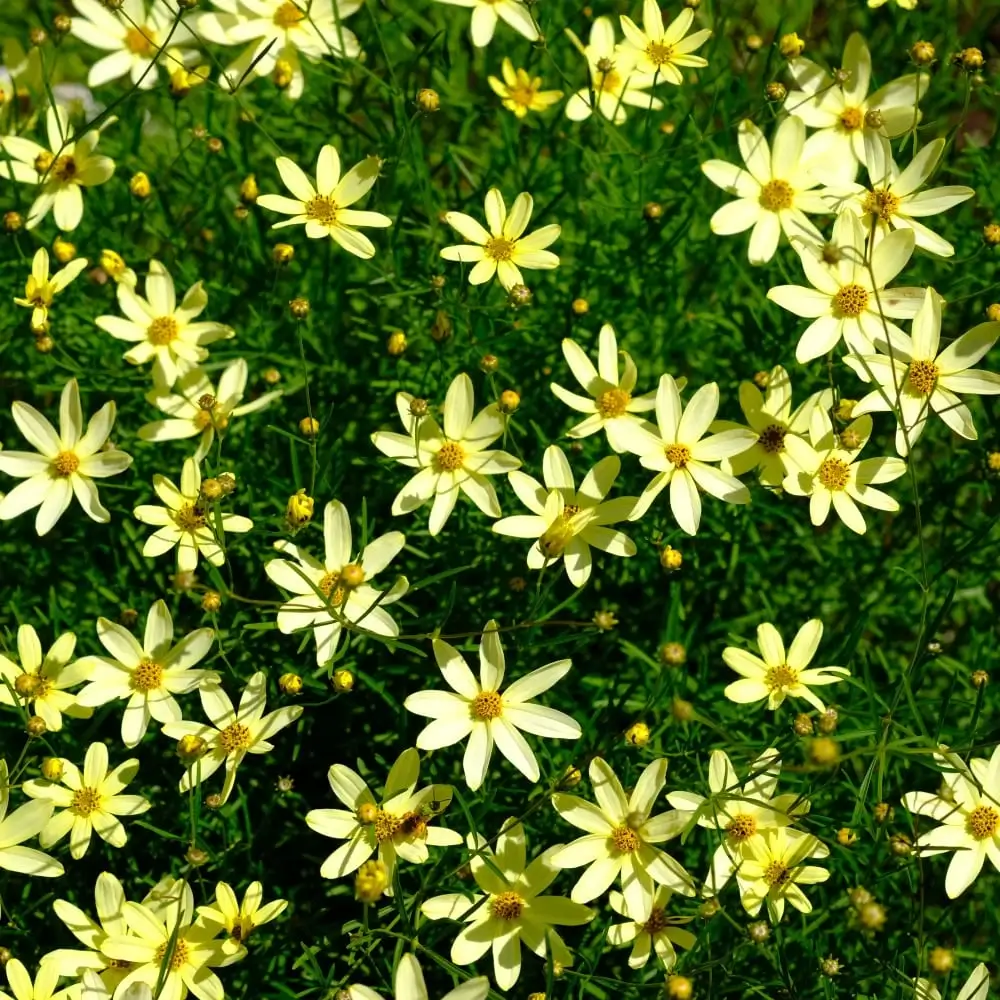Family: Tickseed
Type: Perennial
Other Common Name: Threadleaf Coreopsis

Moonbeam Coreopsis is a perennial star in any garden. Its daisy-like, pale yellow flowers bloom profusely, creating a gentle yet vibrant display. This plant is renowned for its drought tolerance and easy-care nature, making it a favorite among gardeners.
In full sun, Moonbeam Coreopsis thrives, revealing its true potential. Its delicate foliage and airy flowers create a whimsical, meadow-like feel. This hardy plant can survive in various soil types, although it prefers well-drained conditions.
The blooming season of Moonbeam Coreopsis is notably long, from early summer to fall. Its ability to attract butterflies and bees adds an extra layer of life and movement to the garden. This plant is a perfect choice for those seeking low-maintenance yet visually impactful gardening.
Hardiness Zone: 3b-9a
Deer Resistant: Yes
Pet Friendly: Yes
Moisture Preference: Dry to moist
Sun Needs: Full sun
Drought Tolerance (Xeriscape): Yes
Growth Rate: Medium
Average Height (feet): 1.5
Average Spread (feet): 2
Average Life Span (years): 8
Form: Mounded
Flower Color: Yellow
Flower Eye Color: Lemon
Flower Shape: Daisy
Bloom Season: From mid to late summer
Foliage Color: Green
Foliage Shape: Ferny
Incorporating Moonbeam Coreopsis in your landscape brings a touch of wild beauty. Its light, feathery texture contrasts well with more structured plants. It’s ideal for borders, rock gardens, or as a ground cover.
For a stunning visual effect, plant Moonbeam Coreopsis in masses. Their uniform height and color create a sea of yellow that sways gracefully in the breeze. They also work well in mixed perennial beds, offering a consistent color theme.
Moonbeam Coreopsis can be a focal point or a complementary element. Pair it with plants that have dark foliage for a dramatic contrast. Or, use it to soften the edges of pathways and driveways.

Moonbeam Coreopsis is perfect for the relaxed style of a cottage garden. Its informal growth habit and dainty flowers blend seamlessly with other cottage garden favorites like lavender and roses. Plant them along pathways or around sitting areas for a charming, rustic look.
In a pollinator garden, Moonbeam Coreopsis shines as a beacon for bees and butterflies. Its long blooming season provides a consistent source of nectar. Surround it with other pollinator-friendly plants like salvia and echinacea to create a vibrant and life-supporting habitat.
Moonbeam Coreopsis suits the modern minimalist garden with its simple yet striking appearance. Its clean lines and unassuming color palette complement the sleek, contemporary garden design. Plant in geometric patterns or along straight lines for a neat, modern look.
Moonbeam Coreopsis looks stunning when planted along walkways. Its bright flowers create a welcoming path for visitors. Use it to line the edges of garden paths or driveways for a natural yet orderly appearance.
In mixed borders, Moonbeam Coreopsis adds lightness and movement. Its fine texture contrasts well with larger-leaved plants. It’s an excellent choice for creating depth and interest in border plantings.
For a dynamic garden, combine Moonbeam Coreopsis with annuals. This allows for changing color schemes and textures throughout the seasons. It pairs well with a variety of annuals, providing endless design possibilities.
In spring, Moonbeam Coreopsis begins to show its lush, green foliage. This sets the stage for the upcoming floral display. The plant remains mostly green during this time, preparing for its summer bloom.
Summer is when Moonbeam Coreopsis truly shines. It covers itself in a blanket of pale yellow flowers, creating a stunning display. This is the peak of its beauty, attracting pollinators and adding vibrancy to the garden.
As fall approaches, Moonbeam Coreopsis's flowers start to fade. However, its presence in the garden remains strong. The plant's structure and remaining blooms continue to add interest, even as the colors soften.
During winter, Moonbeam Coreopsis dies back to the ground. This dormancy is a natural part of its cycle. The plant's absence in winter allows for planning and anticipation of its spring return.
Moonbeam Coreopsis thrives in sunny locations with good air circulation. Ideal spots are open areas in your garden, such as borders or alongside walkways, where they can receive at least six hours of sunlight daily. Avoid overly shaded areas to ensure healthy growth and abundant flowering.
Full sun is essential for Moonbeam Coreopsis to flourish. It needs at least six to eight hours of direct sunlight each day. Inadequate sunlight may lead to fewer blooms and a leggy growth habit. In hotter climates, some afternoon shade is beneficial.
Well-drained soil is crucial for Moonbeam Coreopsis. It prefers a neutral to slightly acidic pH. While adaptable to various soil types, avoid waterlogged or overly clay-heavy soils. Amend the soil with organic matter to improve drainage if necessary.
Space Moonbeam Coreopsis plants about 18-24 inches apart. This spacing allows for adequate air circulation, reducing the risk of fungal diseases. It also provides room for growth, ensuring each plant can reach its full potential without overcrowding.
The best time to plant Moonbeam Coreopsis is in the spring after the last frost. This gives the plant time to establish its root system before the hot summer months. In warmer climates, planting in the fall is also an option, allowing for winter growth.
Plant Moonbeam Coreopsis at the same depth it was in its pot. Dig a hole twice as wide as the root ball, place the plant in, then backfill with soil. Water thoroughly after planting to settle the soil and eliminate air pockets.
Water regularly during the first growing season to establish a deep, extensive root system. Once established, Moonbeam Coreopsis is drought-tolerant and needs only occasional watering, especially in dry spells.
Fertilize lightly in the spring with a balanced, slow-release fertilizer. Over-fertilizing can lead to excessive foliage at the expense of blooms. Moonbeam Coreopsis does not require heavy feeding.
Deadhead spent blooms regularly to encourage continuous flowering. In late fall, cut the plant back to the ground to help prevent disease and to tidy the garden.
In spring, remove any old growth and apply a layer of compost around the plants. This is also the time to divide overcrowded clumps to rejuvenate growth and promote vigorous flowering.
During summer, keep an eye on watering, especially in prolonged dry spells. Continue deadheading to prolong the blooming period. Watch for pests and treat as necessary.
In fall, reduce watering as the plant prepares for dormancy. After the first frost, cut back foliage to ground level. Apply a light layer of mulch to protect the roots in winter.
Moonbeam Coreopsis is dormant in winter. No active care is needed during this time, but ensure the soil drainage is adequate to prevent root rot in wet conditions.
Moonbeam Coreopsis blooms from early summer to fall. With proper care and deadheading, you can expect a continuous display of flowers throughout this period. The individual blooms last several weeks.
Yes, Moonbeam Coreopsis can grow in pots. Ensure the pot has adequate drainage holes and use a well-draining soil mix. Regular watering and fertilizing are more crucial in container gardening to maintain healthy growth.
Moonbeam Coreopsis is generally deer-resistant, making it a good choice for gardens in deer-prone areas. While no plant is completely deer-proof, Moonbeam Coreopsis is not a preferred food source for deer.
Sign up below to be the first to learn about exclusive deals, discounts, and new collections!
We’ll also deliver the latest tips, trends, and gardening inspiration straight to your inbox.
A big thank you for subscribing to the PBN Design newsletter.
We're thrilled to have you join our community. Get ready for exciting updates, insightful content, and more delivered straight to your inbox.
Stay tuned!
Go backA big thank you for subscribing to the PBN Design newsletter.
We're thrilled to have you join our community. Get ready for exciting updates, insightful content, and more delivered straight to your inbox.
Stay tuned!
Go back